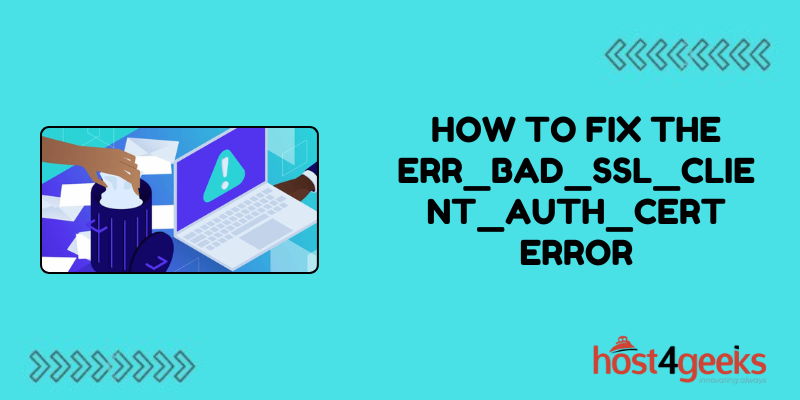In the digital age, security is paramount, especially when it comes to online transactions and communications. Secure Socket Layer (SSL) certificates play a crucial role in encrypting data and ensuring secure connections between clients and servers.
However, encountering errors like ERR_BAD_SSL_CLIENT_AUTH_CERT can disrupt these connections and pose challenges for users.
In this comprehensive guide, we’ll delve into the significance of how to fix the ERR_BAD_SSL_CLIENT_AUTH_CERT Error, its implications, and provide step-by-step solutions suitable for beginners and experts alike.
Understanding ERR_BAD_SSL_CLIENT_AUTH_CERT Error:
ERR_BAD_SSL_CLIENT_AUTH_CERT is an SSL error code indicating a problem with the client authentication certificate. When a client attempts to establish a secure connection with a server, it presents its SSL certificate for authentication.
If the server encounters issues validating this certificate, it generates the ERR_BAD_SSL_CLIENT_AUTH_CERT error, indicating a failure in the SSL handshake process.
Significance of ERR_BAD_SSL_CLIENT_AUTH_CERT Error:
This error is significant as it disrupts secure communication between a client and server, potentially exposing sensitive data to security threats.
Resolving this error is crucial for maintaining the integrity and confidentiality of online transactions, protecting user privacy, and ensuring a seamless browsing experience.
Causes of ERR_BAD_SSL_CLIENT_AUTH_CERT Error:
Several factors can trigger the ERR_BAD_SSL_CLIENT_AUTH_CERT error, including:
1. Invalid or expired client authentication certificate.
2. Mismatch between the client’s certificate and the server’s requirements.
3. Configuration issues on the client or server side.
4. Network disruptions or firewall restrictions interfering with certificate validation.
5. Security vulnerabilities or attacks compromising SSL/TLS protocols.
Step-by-Step Solution for Beginners:
For beginners, resolving ERR_BAD_SSL_CLIENT_AUTH_CERT error can seem daunting. However, following these steps can help:
Step 1:
Check Certificate Validity: Ensure that your client authentication certificate is valid and has not expired.
Step 2:
Verify Certificate Configuration: Review the certificate configuration settings to ensure compatibility with the server’s requirements.
Step 3:
Renew or Obtain a New Certificate: If your certificate is invalid or expired, renew it or obtain a new one from a trusted Certificate Authority (CA).
Step 4:
Clear Browser Cache: Clear your browser’s cache and cookies to eliminate any stored outdated certificate data.
Step 5:
Restart Browser and Network: Restart your browser and network connection to refresh settings and establish a new SSL handshake.
Step 6:
Update Browser and Operating System: Ensure your browser and operating system are up-to-date with the latest security patches and updates.
Step 7:
Disable Antivirus or Firewall: Temporarily disable antivirus or firewall software that may be blocking SSL connections or interfering with certificate validation.
Step 8:
Contact Support: If the error persists, contact the website’s support team or your network administrator for further assistance.

Pros:
– Straightforward steps suitable for beginners.
– Addresses common causes of ERR_BAD_SSL_CLIENT_AUTH_CERT error.
– Doesn’t require advanced technical knowledge.
Cons:
– May not resolve complex issues requiring in-depth troubleshooting.
– Reliance on support teams or administrators for assistance.
– Temporary solutions like disabling antivirus/firewall pose security risks.
Step-by-Step Solution for Experts:
For expert users familiar with SSL/TLS protocols and server configurations, resolving ERR_BAD_SSL_CLIENT_AUTH_CERT error involves more advanced steps:
Step 1:
Review Server Logs: Check server logs for detailed error messages or clues about the root cause of certificate validation failure.
Step 2:
Verify SSL/TLS Configuration: Review server SSL/TLS configuration settings, including cipher suites, certificate chain, and protocol versions.
Step 3:
Check Intermediate Certificates: Ensure that intermediate certificates are properly configured and chained to the root CA certificate.
Step 4:
Test Certificate Chain: Use online SSL validation tools to test the integrity and completeness of the certificate chain.
Step 5:
Update SSL/TLS Libraries: Update SSL/TLS libraries and dependencies on the server to the latest versions to patch known vulnerabilities.
Step 6:
Implement Certificate Revocation Checks: Enable certificate revocation checks to ensure that expired or revoked certificates are not accepted.
Step 7:
Enable Debugging Mode: Enable debugging mode on the server to capture detailed information about SSL handshake failures for troubleshooting.
Step 8:
Configure SSL Stapling: Implement SSL stapling to enhance certificate validation efficiency and security.
Step 9:
Monitor Network Traffic: Use network monitoring tools to analyze network traffic for anomalies or potential security threats.
Step 10:
Consult Documentation and Communities: Refer to official documentation, forums, or communities for SSL/TLS best practices and troubleshooting tips.
Pros:
– In-depth troubleshooting steps suitable for experienced users.
– Addresses complex issues and advanced configuration settings.
– Encourages proactive security measures and continuous monitoring.
Cons:
– Requires advanced knowledge of SSL/TLS protocols and server administration.
– Time-consuming process with potential for trial and error.
– May involve modifying server configurations, risking service disruption if not done carefully.
Conclusion:
Resolving ERR_BAD_SSL_CLIENT_AUTH_CERT error is crucial for maintaining secure communication between clients and servers. Whether you’re a beginner or an expert, following the appropriate steps outlined in this guide can help diagnose and fix SSL certificate authentication issues.
By understanding the significance of how to fix the ERR_BAD_SSL_CLIENT_AUTH_CERT error and implementing the recommended solutions, you can ensure the integrity, confidentiality, and reliability of your online transactions and communications in today’s digital landscape.
